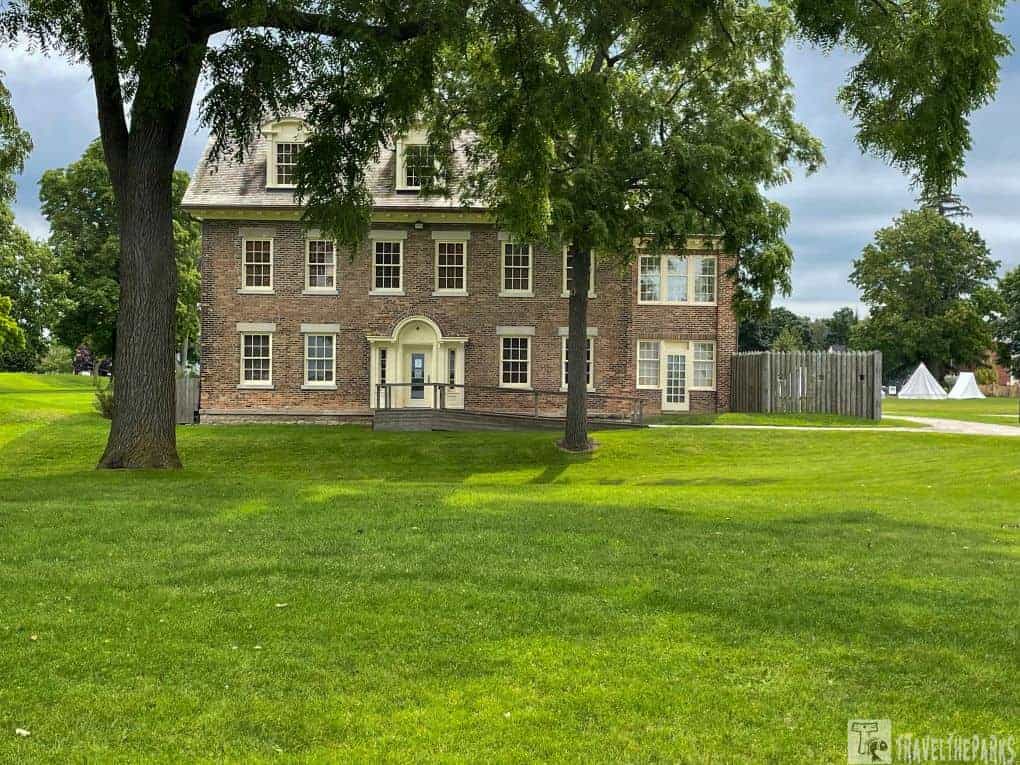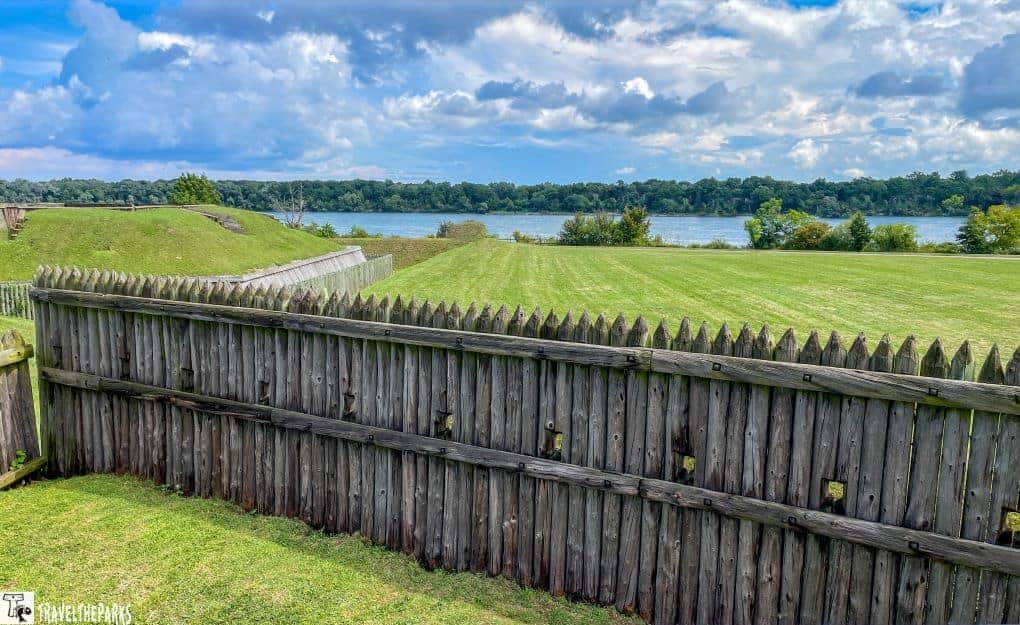There is always something new to discover when history comes to life at mighty Fort Malden National Historic Site in Ontario, Canada. Not too far away from the city of Detroit, near the idyllic town of Amherstburg, you can take a step back through time at Fort Malden. The fort dates back to before the War of 1812 and the Rebellions of 1838. Take a tour of the authentic fort. You can talk with costumed interpreters, learn the strategic importance of the fort and see muskets demonstrations. The military history of the fort spans over 225 years. As we traversed the reconstructed structures, peered into historic rooms, and interacted with dedicated re-enactors, we found ourselves transported to a time when the clash of muskets and the whispers of diplomacy shaped the world.

Welcome to the hallowed grounds of Mighty Fort Malden, a place where history comes to life in vivid and captivating ways. The fort was a British stronghold during the War of 1812; well positioned on the shores of the Detroit River near the mouth of Lake Erie. This formidable fortification stands as a sentinel of heritage, a living testament to the events and individuals that shaped the course of nations.
This post may contain affiliate links, meaning if you purchase something through one of these links, we may earn a small commission at no extra cost to you! Read the full disclosure policy here.
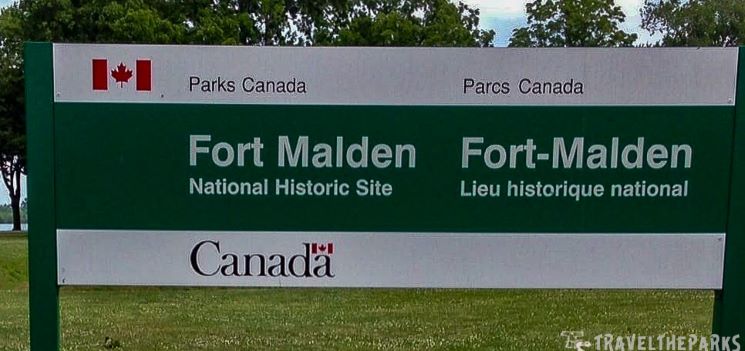
Table of Contents
The Significance and Legacy of Historic Fort Malden
The British built the fort as a defense against invasion by the USA. It was the headquarters for the Right Division of the British Army. They continuously occupied it during the War of 1812. They designated Fort Malden a national historic site on December 28, 1940. Its primary role was to defend the western frontier during the War of 1812. The fort was first called Fort Amherstburg, built in 1795 to protect and secure British interest. The fort was the site of the historic meeting between Sir Isaac Brock and Chief Tecumseh. It was during this meeting they planned the Siege of Detroit.
NOTE: Brock really showed his leadership skills again at the Battle of Queenston Heights close to Fort George in October 1812. Even though he was fatally injured during the fight, his contributions were key to the British and Canadian forces winning the battle.
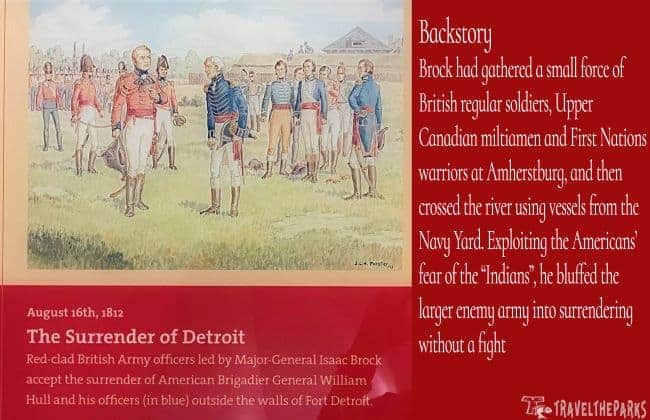
It was June 18th 1812 when the United States declared war on Britain (Canada). The reasoning was rising tensions with Britain over a maritime blockade against American ships during the Napoleonic Wars. They claimed that the high seas were a free trade zone and accused the British of supporting indigenous uprisings. American president James Madison signed a declaration of war in June 1812. Although many indigenous fought on both sides, Spain supported Britain while France fought against the forces of both under Napoleon.

The fort eventually fell to the Americans in the Battle of the Thames on October 5, 1813. It was during this battle that Chief Tecumseh died. The Americans held it until February 1815, when the Treaty of Ghent was signed, thus ending the war.
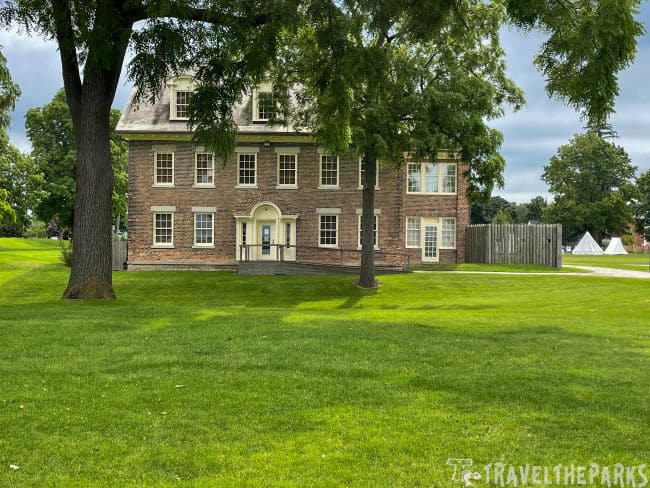
What to know before you go: Fort Malden Historical Experience
- Operating Hours for 2025: May 17 to June 29: Wednesday to Sunday, 10 a.m.–5 p.m. July 1 to August 31: Daily, 10 a.m.–5 p.m. September 3 to October 12: Wednesday to Friday, 1 p.m.–5 p.m.; Saturday and Sunday, 10 a.m.–5 p.m.
- Admission Fees: Adults (18 to 64 years): $4.50, Seniors (65 years and over): $4.00, Youth (17 years and under): Free
- Pets: Fort Malden National Historic Site in Amherstburg, Ontario, is a pet-friendly destination. Visitors are welcome to bring their pets, provided they adhere to the following guidelines: Pets must be kept on a leash and under the control of their handler at all times.
- Best times to visit: Summer (June to August): Full programming, warm weather, and special events. Spring (Late May to June): Mild weather and fewer crowds. Fall (September to October): Fall colors and a quieter experience. Winter (November to March): Weather is much colder. Keep in mind that some services and programs may be reduced or unavailable in the winter months.
- The self-guided tour brochure is available at the desk or downloaded here.
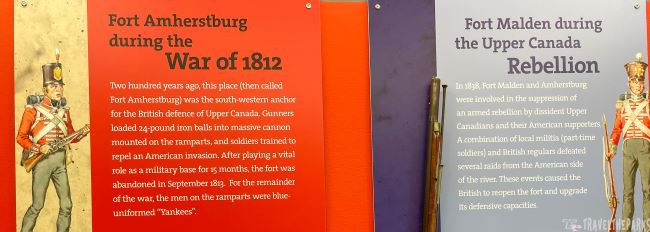
Fort Malden has its history intertwined with the entire southern Ontario peninsula-Upper Canada. You enter the fort via the visitor center/gift shop. At the first stop, we encountered a knowledgeable young lady behind the desk. She provided us with a map of the fort and gave us a brief orientation. We learned they constructed the building in 1839 to resemble an old french chateau.
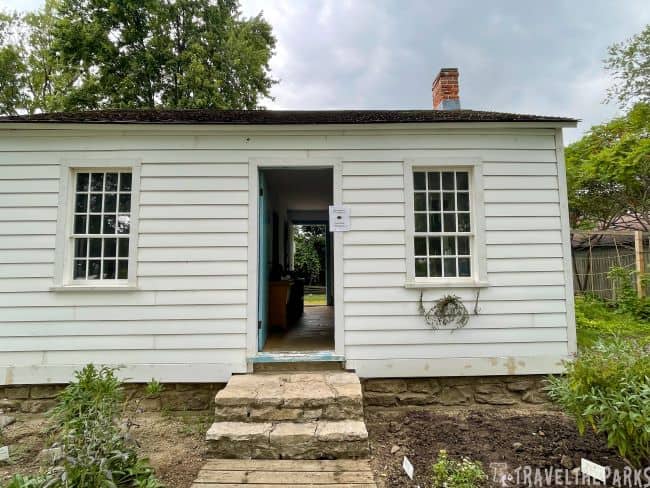
Pensioner’s Cottage: Step Back in Time at Fort Malden
The pensioners’ Cottage is a good starting point for your self-guided tour. They built the simple two-room cottage in the early 1850s. They constructed approximately 85 of these homes just east of the fort. Veteran soldiers, in exchange for light military duty, could lease the cottages at a minimal rate. Earl Grey, the Colonial Secretary, solicited using pensioners to maintain the fort to avoid having soldiers present. This restored cottage was relocated and previously belonged to Charles O’Connor. The lot is an example of what the pensioners program and 2 acre lot would have looked like circa 1851.
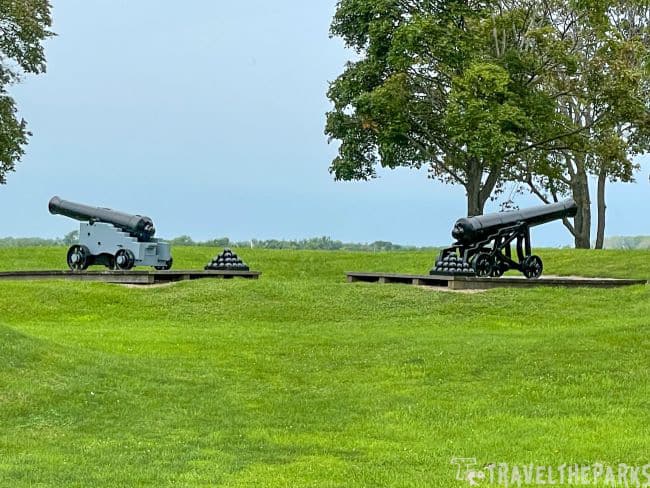
Fort Malden Earthworks: Tracing the Footprints of History
The perimeter earthworks provide the fort with a significant defensive structure. The trenches were dug by American troops after they seized the fort in 1813. Wooden palisades with four bastions occupied the corners and a central guard house. The interpretive kiosk states, ” in front of you is a recreated piece of the fort’s palisade a vertical wall of shaped logs. This wall surrounded the fort, linking the four diamond-shaped corner projections, called bastions. Around each bastion, the palisades ran in the bottom of a ditch that served as an additional defense against attacking soldiers.”
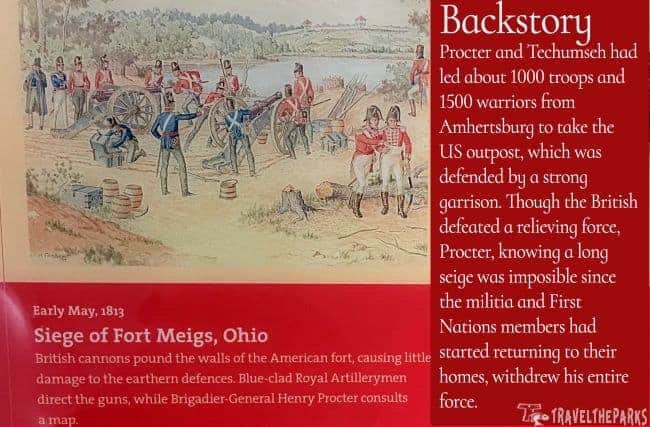
Fort Malden War of 1812 Experience: Exploring the Rich History of Fort Malden Museum
Built circa 1861, the museum building houses artifacts and historical information spanning the years 1796 through 1813. They dedicate the first floor to the early history of the fort, particularly the War of 1812. I found the information on Chief Tecumseh particularly interesting. Moving upstairs, the information covers “The British Wore Red” detailing how that British military troops dressed in several styles and colors. It also has educational displays that cover more of the Rebellion of 1838-1839. Important to note that they continually occupied the fort from 1796 to 1813, although it changed hands many times.
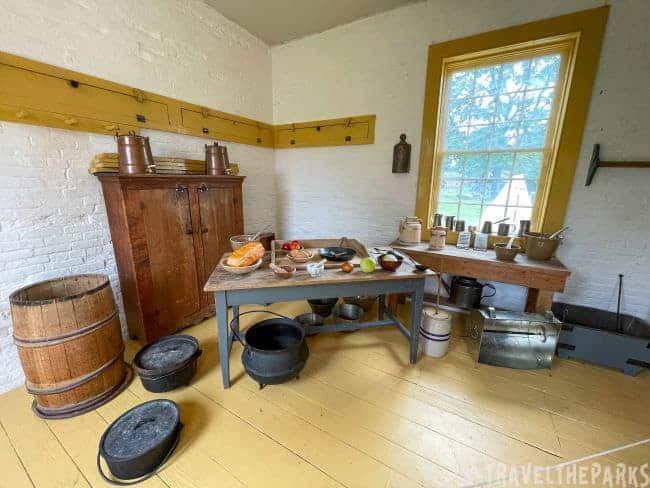
They added the cooking and laundry to the original barracks building while they used the fort as an “insane” asylum. Leaving the museum, you enter onto the fort parade grounds.
Entering the grounds, you see many young summer students in period uniforms circa 1840. These guides described the buildings and painted us a picture of what daily life was like at the fort during the 19th century. They were extremely helpful in answering our questions.

A Temporary Refuge: The Not so Alluring Belle Tents
Belle Tents harken back to a simpler era. They used these canvas structures during the construction of the barracks in 1839. Belle tent encampments temporarily quartered the soldiers of the 34th Regiment of Foot in Belle Tents. Each tent would hold approximately 12 soldiers. Tight quarters indeed! The timeless design truly is nomadic.
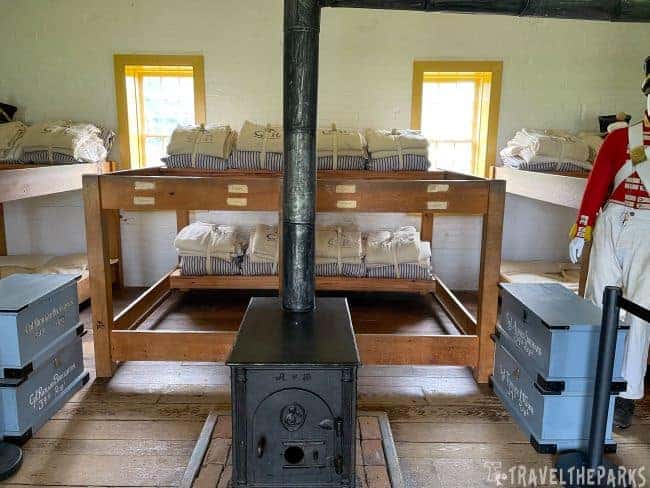
Exploring the Original Fort Barracks of Magnificent Fort Malden
Rubblestone foundations within the fort are all that remains of the ordnance shed (1820), Officer’s brick barracks (1839), Brick officers guard room and staff sergeants’ quarters (1839). These structures, although hard to visualize, must have been impressive. The Officer’s Brick barracks would have had two stories, with eight rooms on the main floor and four rooms on the upper level. Each officer had their own room with a fireplace.
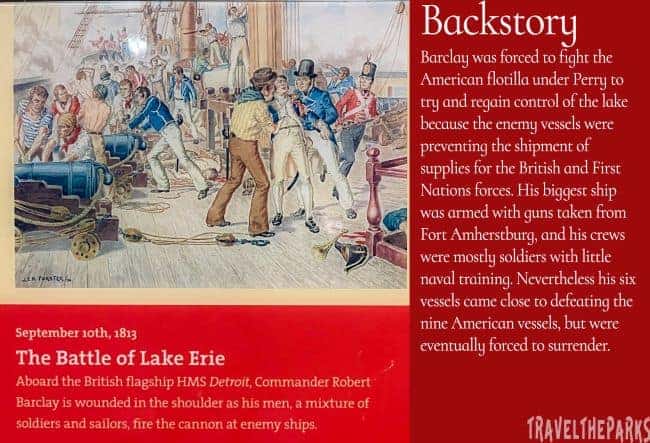
Resurrecting History: Exploring the Fort Malden Restored Brick Barracks (circa 1819)
The restored single story Brick Barracks circa 1819 housed 66 soldiers in three rooms. It is the centerpiece of the fort. The guide, wearing the 34th Regiment of Foot for the Canadian Rebellion, explained how the barracks for officers were spacious and luxurious compared to the soldiers sleeping arrangements of bunk beds with only three feet of spacing between them. One room displayed what the officers’ quarters looked like, with the warm fireplace, while the other room had little room and provided only a small wood stove for heat.
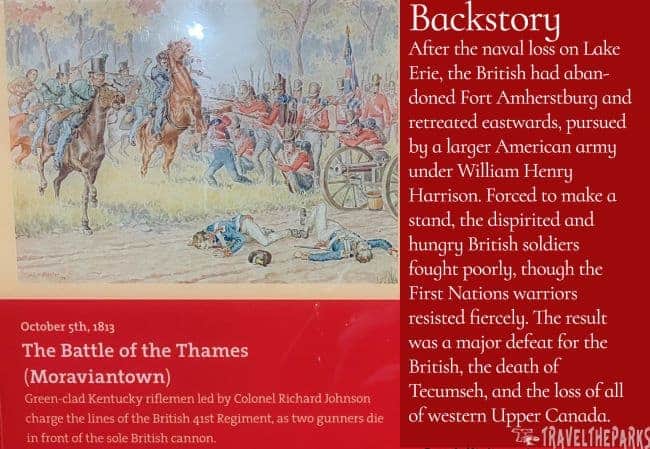
Culinary Chronicles of the Past: The Fort Malden Hospital Kitchen of Circa 1840
The soldier and officers’ barracks were later converted to a hospital during its years as an asylum. Built as an addition to the brick barracks in the year 1842, when the fort was operating as an asylum. Inside is an enormous fireplace that used massive boilers to prepare the food for the hospital patients.
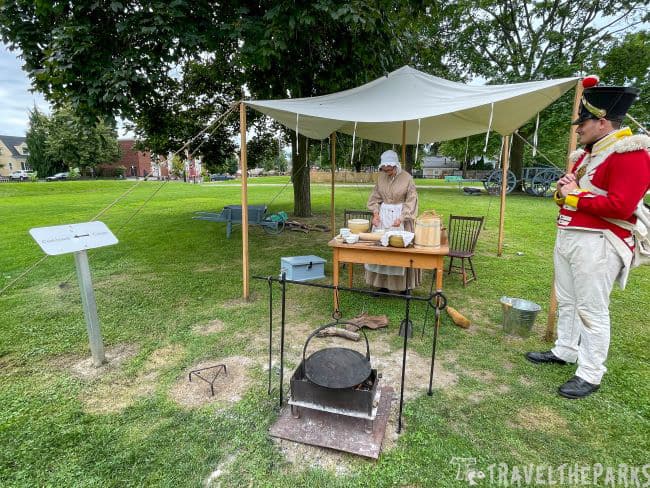
Interactive History at Fort Malden: Soldiers Cookhouse and its Savory Beef Stew
Next we saw the soldiers cookhouse that serves beef stew so you can enjoy a hardy lunch, just like the soldiers of yore. It includes a bowl of soldier beef stew, a chuck of local bread and dessert. People said that it would keep soldiers marching, providing morale and keeping up their strength during wartime.
We continued our guided tour viewing the excavated remnants of the privies (latrines), and the surviving stone foundations of the cesspit where you can view the drainage system for the buildings. The stone foundations of the cesspit and privies occupy the backside of the fort (1821). The foundation of the original brick cookhouse dates to the early 1820s. They removed the cookhouse from the living quarters as a fire prevention precaution. They decided to demolish it in 1853 due to its poor condition.

Forging Mobility: The Royal Artillery Traveling Blacksmith Forge
Portable forges travelled between the various forts in Upper Canada. Construction carpenters and builders often sought after them in helping with maintaining the fort with supplies. The forge also made nails, hammers, tent stakes, and other utensils used within the fort. I loved the demonstration of the forge included branding or watermarking the equipment. This was supposed to deter soldiers or officers with light fingers. I was especially interested in the stories of those that took items only to have to return them with punishment being labeled an admitted thief or continue with their military service until they completed their sentence.

Reenactments at Fort Malden: Musket Demonstrations
Summer students perform the musket demonstration and reenactment in Malden Historical Park. The musket demonstration was definitely the highlight on our guided tour. They hold demonstrations at different intervals throughout the day. The young man that did the show spoke of the relative inaccuracies of the weapon. He stated that they would have been lucky to hit anything that was aimed at. However, when you lined the soldier’s shoulder to shoulder and fired, they were more likely to hit a target. As he loaded the weapon, we held our breath, waiting. The brown Bess musket created a huge puff of smoke, and the report was incredibly loud. It was easy to imagine the firing line being chaos.
Another young lady dressed in period costume explained the use of the cannons and other artillery used by the Right Division of the British Army and the 34th Regiment of Foot. The first piece was the mortar used as a siege weapon that can only fire at a 45-degree angle lob over the rampart walls. It was heavy, however, was movable by t2-4 soldiers in the field when needed. The howitzer cannon was a wheeled cannon much simpler to move during battle. The howitzer, unlike the mortar, was adjustable. However, it did not have the firepower of the 6 pound cannon. These 6 pound cannons, although heavier, had wheels for maneuverability. The cannon would use a minimum crew of four to operate. The cannon could pack a punch in battle.
Keep up to date with the fort by liking their page on Facebook, or by subscribing to their newsletter using the following link. http://ow.ly/b7HU50FbN0y

River to Freedom: Tracing the Link with the Underground Railroad
Canada played a big part in the Underground Railroad. Amherstburg was a terminus of the underground railway for American slaves seeking a free life in Canada. Because the Detroit river is extremely narrow near Amherstburg, it allowed for people to cross the frozen river to Canada. We watched a few of the videos with interviews with family members of people that found their freedom. The young girl that guided us through the church provided us with a whole new appreciation, seeing the hardships and the determination of those who made the trek northward. Though many successfully survived the journey, many did not.

The Amherstburg Freedom Museum is a great place to spend an hour or two learning more about the underground railroad. Founded by Melvin “Mac” Simpson, he dedicated the museum to telling the story of African-Canadians’ journey and contributions. On site is the Taylor Log Cabin-a historic home and the Nazrey African Methodist Episcopal Church. Built by slaves and free blacks in 1848. In 1998, they designated it a National Historic Site.

Embracing Nature’s Seat: Canada’s National Park Red Chair Program
The red chair project connects people with nature in the Canada’s unique and treasured places. We first experience a set of the red Adirondack chairs in Point Pelee National Park and later at Fort George. At Fort Malden, we found the red chairs along the path facing the Detroit river. The location was the perfect place to slow down, to relax and take in the magnificent view of the passing boats and Bob-lo Island.
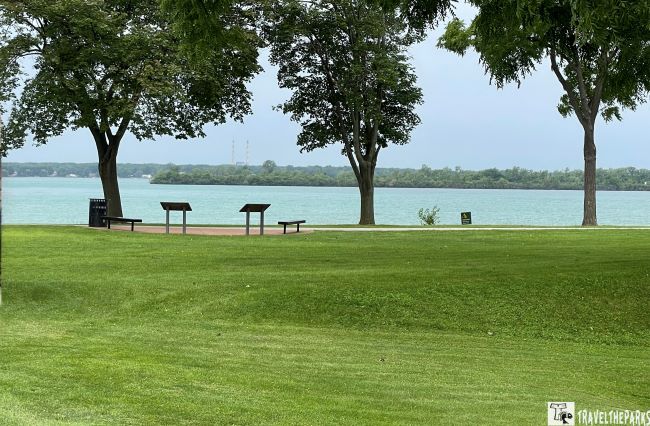
Before leaving, we returned to the visitor center’s small gift shop. I am a collector of National Park passport stamps. Parks Canada does not have a reciprocating program. however, the young girl at the desk could give me a beaver stamp for my passport book. I was delighted, to say the least.

Beautiful Amherstburg on the Shores of the River
Amherstburg is an old historic town dating from the late 1700s. The walkable town has many quaint outdoor patios, charming cafes, and outdoor sidewalk retailers. We spent the afternoon in Amherstburg. First, we visited the Park House Museum. It is renowned for being the oldest home in town. It is part of the Amherstburg Culture Trail. We choose to do a simple self-guided tour for a small entrance fee. The Victorian home was owned by the Dr. Thomas F. Park, hence the name. They restored the 1850s residence as a permanent exhibit (main floor only). Included in the exhibits are the Medicine in History and Loyalist and the Fur Trade. It is worth the short detour to visit.

There are several very good eateries along Dalhousie Street. On this visit, we decided on a light lunch at the Salty Dog Cafe. This cafe offers a great selection of craft beers to enjoy. The lobster tacos are spectacular! Another restaurant that we find is ideal for a late lunch or dinner is Riccardo’s Italian Restaurant, located right on the river’s edge on Dalhousie Street. Italian food at its finest.
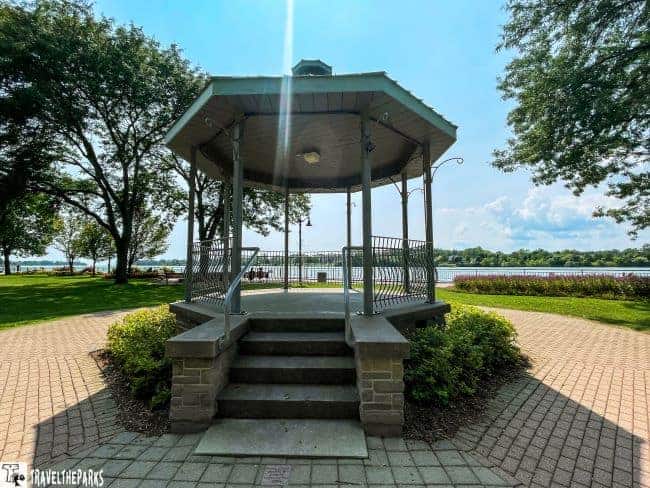
After a bite of lunch downtown, we went for a leisurely walk through the King’s Navy Yard Park. First visit, the Waterfront Ice Cream Parlor for a delightful treat to take on your walk.
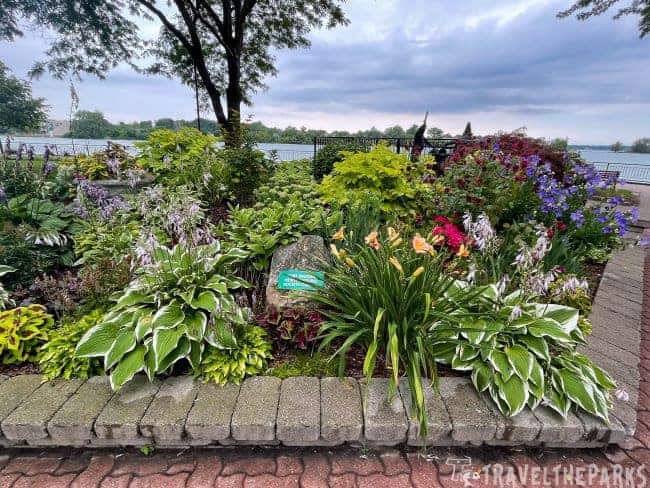
Amherstburg Navy Yard National Historic Site
This national historic site is a 10.5 acre park is a stone’s throw from Fort Malden. Established in 1796, the historic Amherstburg Navy Yard was home to a small contingent of ships during the war. They were primarily used to secure the harbor during the War of 1812. The small town gained notoriety for rope making. According to accounts, rope makers built extremely long lengths of ropes made from locally sourced hemp. Some of which stretched from Fort Malden to the end of the Detroit river. There are plaques and dioramas along the pathway that tell the historic details of the Navy Yard.

We strolled through the beautiful award-winning botanical gardens of the King’s Navy Yard Park. Inlaid brick paths pass through their signature Hosta Garden, which boasts over 250 different varieties of Hostas. On the waterfront pathway is the International Peace Sculpture Forged in Peace created by Joseph de Angelis. Joseph de Angelis created the International Peace Sculpture Forged in Peace, dedicated for the years 1812-2012. It stands on the walkway and states, “Out of war, peace was forged.” A beautiful tribute indeed!
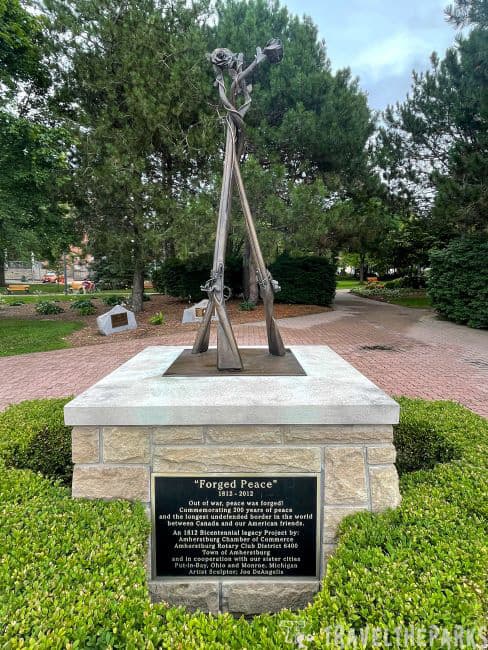
Exploring Gardens and Memorials in Amherstburg
Visitors can look across the river and enjoy panoramic views of Bois Blanc Island (Boblo Island). The island was strategically important in defence of Fort Malden in 1837-38. This was a period that saw border raids from the United States by Canadian rebels. The Bi-Centennial International Peace Garden has benches, a quiet place to relax, have a snack or drink and watch the container ships that pass through on the Detroit River. We enjoyed seeing the cute black squirrels everywhere. At the far end of the waterfront park, anglers had their lines in the water. I asked if they had any luck. They responded that only a few bites were on this overcast day.

The riverfront pathway showcases an aged range light, anchor, and capstan that were moved from Fort Malden National Historic Site. This Range Light, also referred to as Landing Light, functioned as a navigational aid for vessels entering a shallow area, guiding them safely through the Amherstburg Channel. The artifacts used to be on the lawn of the Interpretation building when it was called the Marine Museum. They moved it to the riverfront park in 1981.

Riverfront Hidden Gem: Amherstburg’s Serene Waterside Escape
No visit to Amherstburg is truly complete unless you take a walk through the Navy Yard park to view the old cannons, Informational plaques and a few of the remaining historical building of time gone by.

Four historic buildings are within the confines of the park. One of which is the Commissariat building. They constructed it in 1831 to serve as the office responsible for purchasing and storing goods. Currently, the building is home to the Amherstburg’s Provincial Marine Reenactment Unit.

Next is the Gordon House. Originally used as an infirmary and birthing house for the wives of provincial marines, this Georgian style home is now a Tourist Information Center. Staff can provide brochures, maps and event information for those visiting the area. Getting an illustrated map of Amherstburg gave us a much better idea of what there was to see and do in the area. The Visitor Center is open Monday to Friday from 8:30am to 4:30pm from June through September. There is a tale that this 1798 George Sharp-built building is haunted on the inside. Several antiques decorate the house, including a pram from its heyday as a birth home. Before you leave, be sure to peek at the largest Doll Exhibit.
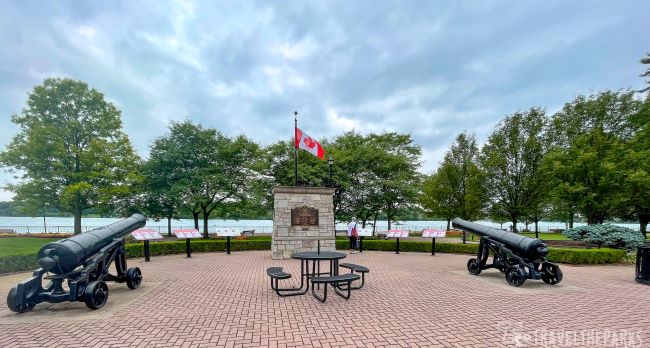
Echoes of the Past: Olde Amherstburg Ghost Tour & more
The Olde Amherstburg Ghost Tour, virtual tour is available through the ON-FOOT app. We downloaded the free tour prior to our visit. If creepy stories and extraordinary history interest you, I highly recommend this tour. You can even get a selfie with a ghost on this tour!
Essex county has recently become a hotbed for many epic wineries. If time permits, visit just a few to sample the 100% Ontario made wines.

A Tale of Bois Blanc Island: A Journey Through History and Heritage
A group of indigenous Wyandot who farmed the fertile soil originally settled the island. They called the island, “Etiowiteendannenti.” The french first named the island, “Bois Blanc” meaning “white woods” after seeing the many beech and white birch trees that covered the island.

The island is most remembered as the home to Bob-Lo Island amusement park in late 1898. Today the three-mile long island is part pristine island, and part gorgeous mansions. Today, the small island has seasonal restaurants and a colorful past. During its heyday, the riverboats SS Ste. Clair (burned in 2018) or SS Columbia ferried passengers from Detroit. The steam-powered riverboats ran the 18-mile upriver to island park.
Boblo Island Amusement Park ran from 1898 to 1993. The early amusement park was renown for its enormous dance hall, romantic Swan boats and other thrilling midway rides. Many families made the annual passage to the island to picnic and enjoy a day away. The park closed in 1991. Sadly, the end of an era. YouTube Video Bob-Lo Island.
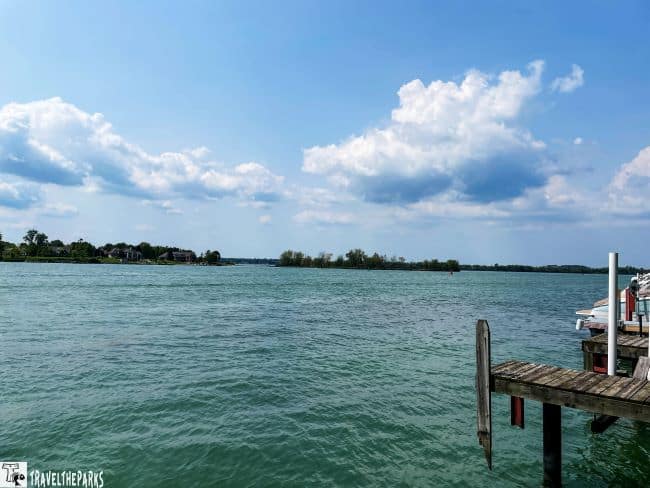
Tracing the Haunting Legacy of What Remains – Ghosts of Bois Blanc Island
Today, the island is only accessible from Amherstburg via a short 2-minute ferry ride. If you plan to visit the island, the only way to see the south end is to walk, bike or use a golf cart. They strictly prohibit vehicles. Gone is much of the original amusement park. Although the eerie haunting remnants of the dance hall, entertainment theater, and space needle still stand. What lingers today are the memories of the thrills of the many families that made the annual pilgrimage to the island for a day of adventure.
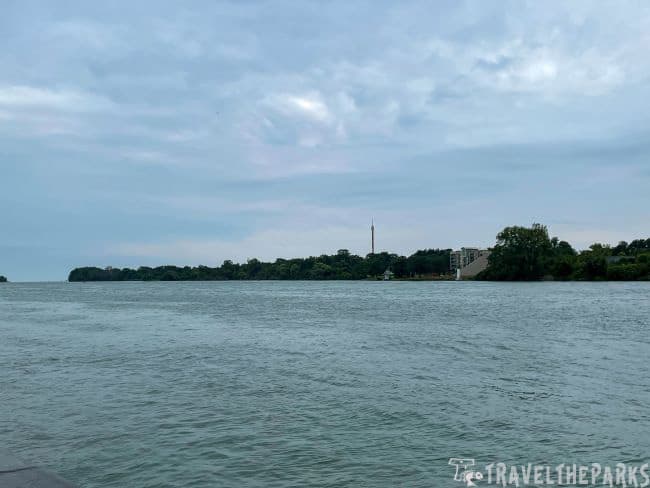
Guiding Light of Bois Blanc Island Lighthouse National Historic Site
The lighthouse on the island has withstood the test of time. Bois Blanc Island Lighthouse National Historic Site has, for more than a century, been a navigational beacon for mariners. Local limestone was used to build it in 1836, and Captain James Hackett became its first keeper. The lighthouse’s diameter at its base is 18 feet (5.5 m) and it reaches a height of 40 feet (12 m). They upgraded the lighthouse many times over the decades.

Later, it became decommissioned and it no longer functions. They designated the Imperial Style lighthouse a historic site in 1955. In 2015, they protected it under the Heritage Lighthouse Protection Act owned by Parks, Canada. The lighthouse is NOT open to the public, but visitors can still see the exterior either from the water or by combining it with a visit to the blockhouse.

Preserving History: Exploring the Restored Blockhouse on Bob-lo Island
The one recent addition is a restored blockhouse. Bois Blanc island was strategically important to the British during the War of 1812. During the rebellion of 1837, insurgents from the United States were loyal to William Lyon Mackenzie. They invaded Bois Blanc Island in the winter of 1838. British troops from Fort Malden captured the 60 invaders and build three log blockhouses on Bois Blanc Island over the winter of 1838-1839 to defend the island from further attacks. They originally completed the construction of this last remaining blockhouse on June 22, 1839.
The blockhouse housed regular troops from Fort Malden until 1851 and thereafter enrolled pensioners until 1859. They disassembled, restored and reconstructed the blockhouse over a period of three years. Senior artisans assisted by volunteers and entirely funded by local donors in 2013-2014 performed the reconstruction. The blockhouse is open for tours on Sunday from 1pm to 5pm.
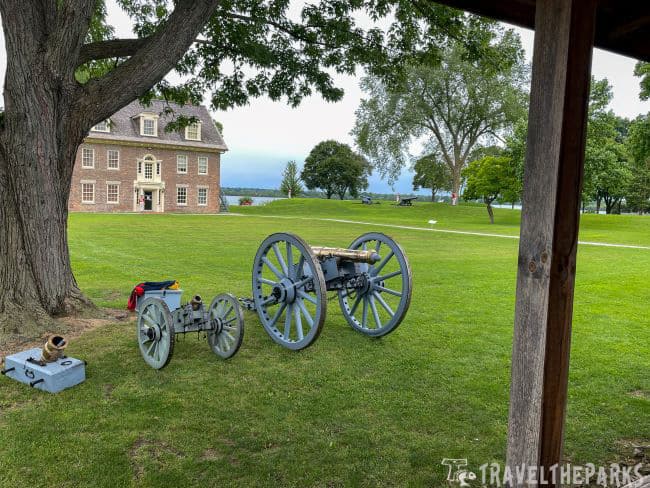
Final Thoughts on History Comes to Life at Mighty Fort Malden
Amherstburg is a pleasant and quiet retirement town that is a true hidden gem. Fort Malden National Historic Park is a fantastic way to learn about the history of Upper Canada while visiting the waterfront park. I think that if you are a history buff like I am, then you will appreciate what Fort Malden offers. I often imagine what stepping back into the time of 1812 must have been like. Daily life was very different and I appreciate learning when I travel. Families with kids will enjoy the educational demonstrations and it is the perfect location for a family picnic along the waterfront.
Have you had the opportunity to visit Fort Malden? If you visited, what would be your takeaway? Please share your thoughts in the comments below.

